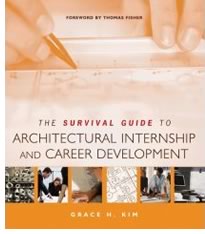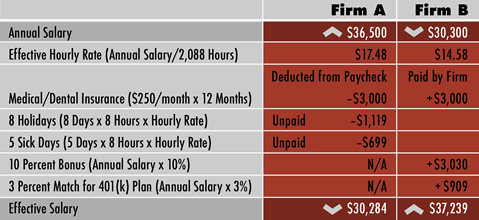

4/2006

by Grace H. Kim, AIA
Excerpted from The Survival Guide to Architectural Internship and Career
Development
 When thinking about your ideal employer,
it’s important to remember that there are many different types
of architecture firms, not only in terms of the projects they take on
or their designs, but also in terms of business practices and service
delivery methods. Although there is no industry-prescribed classification
of firm types, several books attempt to distinguish the various business
models firm use. For example, The Architect’s Handbook of Professional
Practice, 13 ed., describes six archetypes: Einsteins, Niche Experts,
Market Partners, Community Leaders, Orchestrators, and Efficiency Experts.
These archetypes have specific characteristics that provide direction
for marketing and business decisions:
When thinking about your ideal employer,
it’s important to remember that there are many different types
of architecture firms, not only in terms of the projects they take on
or their designs, but also in terms of business practices and service
delivery methods. Although there is no industry-prescribed classification
of firm types, several books attempt to distinguish the various business
models firm use. For example, The Architect’s Handbook of Professional
Practice, 13 ed., describes six archetypes: Einsteins, Niche Experts,
Market Partners, Community Leaders, Orchestrators, and Efficiency Experts.
These archetypes have specific characteristics that provide direction
for marketing and business decisions:
The Einsteins are innovators, generating new ideas and technologies. They produce high-profile designs and generally have a strong research focus, with firm leaders who teach and publish. They are distinctly known for their philosophies, which can transcend geopolitical borders.
The Niche Experts are specialists, with a focus on particular project types or services in a given market. They closely watch the developments of the Einstein firms and cater to specific market needs that are not being met.
The Market Partners lead in one or more major markets, such as health care or airports. They build their practice around these markets by sharing the values of their clients, attending industry trade events, and creating personal relationships with diverse members of the industry. Former client-side staff may hold marketing and project management positions in Market Partner firms.
The Community Leaders maintain leadership roles within their towns or region that allow them to expedite political decision making and overcome obstacles more quickly than outsiders. Their commitment to and knowledge of the community make them invaluable team leaders to their clients. Their project base includes premier public buildings such as schools, recreation centers, and other municipal structures.
The Orchestrators focus on project management for complex projects, with an emphasis on speed, coordination, and control. As the client’s advocate, they ensure that complex projects stay within budget and schedule. Of the six archetypes, the Orchestrator is most in tune with corporate businesses and is the most likely to have firm leaders holding MBAs.
The Efficiency Experts base their business on prototypes and site-specific applications of standardized designs. Their primary objective is to help their clients achieve financial success through fast and inexpensive volume rollouts. Efficiency Experts may provide expanded services that delve into the realm of real estate development and program management.
Although it may be difficult to determine whether a particular firm is of one of these archetypes, it may be helpful to determine which archetype satisfies your architectural aspirations or simply to acknowledge that the differences exist. Knowing that you are interested in sports facilities may indicate that you should be looking for firms that are Niche Experts, such as Ellerbe Becket, HOK Sports, or NBBJ. Conversely, if you are not sure of the type of projects you want to work on, but you know that you are interested in working on local projects and becoming active in your community, you may seek out firms that are Community Leaders and that may not be nationally recognized but have outstanding reputations, such as OWP/P in Chicago and Pyatok Architects in Oakland.
The book Architect’s Essentials of Starting a Design Firm provides another perspective by narrowing the types of firms to three major categories [based on a concept introduced in Success Strategies for Design Professionals]—Strong-Idea, Strong-Service, and Strong-Delivery—with two types of management styles: practice-centered and business-centered.
For the purpose of selecting the type of firm for which you would like to work, these categories may prove more helpful. At first glance, they may seem more general than the categories outlined in The Architect’s Handbook, but you will soon see the similarities.
Strong-Idea firms have a strong design focus, producing signature projects with a distinctive architectural style. Cutting-edge design and innovation are primary objectives of their practice. Design awards are a significant measure of their success. Einsteins and Niche Experts are the types of firms that have developed their practice around creating big ideas.
Strong-Service firms are customer-service oriented, with client satisfaction being a primary concern. Repeat clients and client referrals are signs of their success. Awards generally come from industry associations and organizations. Market Partners, Community Leaders, and Orchestrators provide this client-focused approach.
Strong-Delivery firms focus on the business of architecture. The productivity of the firm and its employees is as important as its product; repetitive building prototypes are favored over single-application design solutions. Efficiency and profitability for both the client and the firm define success. Efficiency Experts are prime examples of this type of firm.
These categories are not black-and-white, and most firms will likely be a combination of types. It is mainly important to recognize that there are different types of firms, and that you should evaluate your values and interests to see if they align with the firms you are considering for employment.
Putting this information to use
Regardless of the type of firm you select, some generalizations can be
made about the quality of your internship experience based on the size
of the firm. Although these are broad-brush statements about large
corporate firms versus small-to-midsize firms, a quick survey of interns
two to three years out of school suggests they generally hold true.
To get a more accurate picture of a firm you are considering, it would
be best to talk with interns in similar positions at that office. If
you are extended an offer for a position, you could request to speak
with an intern currently employed at the firm to hear about his or
her experiences.
Generally speaking, larger firms will provide you with more resources and a structured internship experience. Your first day at work will feel organized, with a formal orientation, forms to complete, and introductions to various people and departments within the firm, However, over the course of an internship, your role may become specialized, and you may have limited exposure to the diverse areas of the practice. In most cases, it is not likely that you will be able to satisfy all of your Intern Development Program (IDP) requirements at a large firm, particularly within the IDP’s minimum three-year time period. On the other hand, the reputation of the firm, scale of projects, and design expectations from clients may provide exciting opportunities.
Conversely, smaller firms are less likely to be as organized for your first day, perhaps to the point of not yet having a desk or computer for you. However, during your internship, a smaller firm will generally provide you with a wide spectrum of experiences. And it is more likely that you will be able to satisfy all of your IDP requirements at a smaller firm within three years. However, unlike the larger firms, the projects may be more limited in scope or size, and design opportunities may be severely limited by budget or client expectations.
Salary Comparison
Once you find a suitable firm, the Survival
Guide advises, give consideration
to the salary and benefits as a single compensation package. The result
may surprise you. In the balance sheet here, Firm A appears to have a
more attractive annual salary. Firm B, however, has benefits that effectively
raise the net salary above that of Firm A.

Copyright 2006 Grace Kim. Published by John Wiley & Sons, Inc. Hoboken,
N.J.
Reprinted with permission.
Copyright 2006 The American Institute of Architects.
All rights reserved. Home Page ![]()
![]()
Grace Kim is principal and cofounder of Schemata Workshop, Seattle.
In The Survival Guide to Architectural Internship and Career Development, she draws from her own experiences to draw up an approachable, understandable, and easy-to-read map meant to accommodate myriad career directions and goals. She also weaves in a wide range of first-person vignettes from students, graduates, and established professionals of every aspect of the development of an architect—from finding the right firm as a student intern, getting through the Intern Development Process, taking the ARE, continuing professional development, launching a firm, or using an architectural background to pursue an alternative career. For more information on the book, visit the AIA Store on AIA.org. [ISBN: 0471692638]
![]()